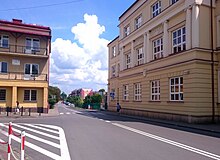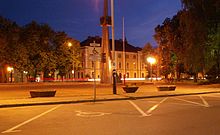Nisko
| Nisko | ||
|---|---|---|

|
|
|
| Basic data | ||
| State : | Poland | |
| Voivodeship : | Subcarpathian | |
| Powiat : | Niżański | |
| Gmina : | Nisko | |
| Area : | 60.96 km² | |
| Geographic location : | 50 ° 31 ' N , 22 ° 8' E | |
| Height : | 220-270 m npm | |
| Residents : | 15,353 (Dec. 31, 2016) | |
| Postal code : | 37-400 | |
| Telephone code : | (+48) 015 | |
| License plate : | RNI | |
| Economy and Transport | ||
| Street : | DK19 | |
| DK77 , ext . 872 | ||
| Rail route : | Rozwadów - Przeworsk | |
| Next international airport : | Rzeszów-Jasionka | |
Nisko is a Polish city in the Subcarpathian Voivodeship . It is the seat of the town and country municipality of the same name ( gmina miejsko-wiejska ). It is the district town of the Powiat Niżański and the seat of the town-and-country municipality of the same name with about 22,400 inhabitants.
geography
The town of Nisko is geographically part of the Kotliny Sandomierskiej , on the edge of the primeval forest of the same name. The San River flows through Nisko. This lies at the intersection of the Kolbuschower plateau, the Tarnogroder plateau and the Bilgorajer lowland. The Sandomir Primeval Forest extends to the west and south, the Janower Forest to the north and the Solsk Primeval Forest to the east.
Nisko as a city covers an area of 61 km². It is located about 86 km southwest of Lublin and about 55 km north of Rzeszów .
history
Before 1868
About 150 archaeological sites in Nisko and the surrounding area, some of which date back to the Neolithic Age, indicate settlement before 1429. In the 10th to 13th centuries, the settlement received a further boost in development.
After the Sandomir jungle came into the possession of the king and the church, the settlement process intensified. The first landowners appeared, including the Tarnowski and Gryfit families.
In the 13th century the population was driven from the devastated villages as a result of the Tatar attacks. The displaced population then settled in the northern area of the Sandomir primeval forest. At this time, the Bieliny settlement was established.
From the early Middle Ages to the 16th century, Nisko was a royal property. In the second half of the 16th century there were conflicts with the princes. The peasants from Nisko presented a letter of appeal to King Stefan Bathory . This exacerbated the conflict which now gripped the entire Sandomir Starostei. The king sided with the peasants. The ordinance issued on November 10, 1583 and other decrees made life easier for the farmers.
The Swedish Wars in the 17th century caused severe damage to the region. After the first partition of Poland, the royal property was added to the church. The region came under Austrian control. From July 14, 1834, court hunter Karl von Reichenbach was the new owner of Nisko.
1868 to 1938
From 1868 to 1912, the village of Nisko, as the center of the Powiat Nisko administrative district, belonged to the Austro-Hungarian dual monarchy . The second largest landowner in the region, Count Roger Rességuier de Miremont, had a hospital, a church, schools, factories and a military garrison built there. Most of these buildings still exist today.
At the beginning of the First World War in 1914, the Russian army destroyed many buildings in the village during their attacks on Austria. In 1918 the Poles captured Nisko and integrated it into the new Republic of Poland . From then on the place flourished and became a city in 1933. In 1938 the Polish government made Nisko part of the central industrial area, Centralny Okręg Przemysłowy . At that time, the construction of a power plant on Nisko's western edge began, but had to be stopped by the German invasion of Poland on September 1, 1939.
time of the nationalsocialism
From October 1939, the National Socialists deported around 5,000 Jews from the “Old Reich” and the newly created “Reichsgauen” to Nisko. They were supposed to set up a transit camp there on their own, supposedly in order to be later "resettled" from there to areas further east.
The then head of the " Central Office for Jewish Emigration in Prague ", Adolf Eichmann , organized six transports to Nisko from October 18-26 , 1939, citing an order from Gestapo chief Heinrich Müller : mainly of Jews from Vienna , Kattowitz and Ostrava in Moravia . In his “welcome speech” in Zarzecze , Eichmann let it be known that the future comers will also be dying (19th). But only a few newcomers were technically able to carry out the ordered camp construction; shortly after their arrival, most of them were driven by armed force across the nearby demarcation line into the sovereign territory of the Soviet Union .
These Jewish deportations - the first after the mass deportation of stateless or illegally living Polish Jews in Germany in October 1938 - are considered to be an experiment in historical studies with which high-ranking representatives of the Nazi regime plans to build a single large concentration camp for all Jews and "unreliable elements “From the German Reich initially wanted to try out and prepare. Reinhard Heydrich considered on September 22, 1939 the establishment of a "Jewish state" or "Jewish reservation" near Krakow , and on September 29 a "Reich ghetto " near Lublin , where a larger ghetto for Jews from Poland was already being established. According to Heydrich, Adolf Hitler permitted the deportation of Jews from the newly created General Government in occupied Poland to Soviet-occupied eastern Poland on September 21, 1939.
After protests by the civil administration, the Wehrmacht and the Soviet Union, Müller Eichmann prohibited further transports on October 21, 1939. An unknown number of the camp inmates were able to flee across the border into the Soviet Union, another unknown number of the forced laborers died of hunger and cold. 501 Jewish craftsmen left in the camp were returned to their places of origin on April 14, 1940.
The plans for a comprehensive “resettlement” of Jews from Germany and occupied territories in Eastern Europe were not dropped, but only postponed to a later date. From February 1941, deportations of Jews to Poland were resumed, and from October 1941 also to the Lublin region. These were already in the context of the “ final solution to the Jewish question ”, which had been planned and started since July 1941 and which had not yet been directly considered in 1939: the Holocaust .
The historian Dieter Pohl judges Eichmann's deportation plans and "experimental transports" in 1939:
"Even here the intention of a long-term genocide is obvious: In the" reservation "the victims should perish from the poor living conditions, those still alive at that time would be the last generation of Jews."
After 1944
The post-war development began with the formation of the Communist Lublin Committee in July 1944. In October Polish resistance fighters were arrested by the Soviet NKVD ; many of them did not return. At the same time there were arrests by the Polish authorities. Due to the new occupation, a new resistance was formed. In 1946 most of the members of the resistance were dead or arrested.
Until 1973 Nisko was a district town, then it was integrated into the Stalowa Wola district. Since January 1st, 1999 Nisko is again the county seat of Powiat Niżański . From 1975 to 1998 Nisko was part of the Tarnobrzeg Voivodeship .
local community
The urban-and-rural municipality of Nisko has an area of 142 km². Six villages with school boards belong to the community .
Sports
There are several sports clubs in the city.
The football clubs, "MKS Sokół Nisko", founded in 1919, the LZS Podwolina and the volleyball club AKS (Amatorski KS) Orkan Nisko. There are also the associations KP Zarzecze, Armes Racławice and the LZS Wiktoria Wolina in the municipality.
There is a stadium in the city for 430 spectators, it is used for the games of "MKS Sokół Nisko". There are also several sports halls in the city.
traffic
- Droga krajowa DK 77 ( Lipnik (Powiat Opatowski) - Przemyśl )
- Droga krajowa DK 19 ( Kuźnica Białostocka (border crossing to Belarus ) - Rzeszów )
- Droga wojewódzka ext. 872 (Nisko - Jasienica )
The Rozwadów - Przeworsk railway and the LHS ( Linia Hutnicza Szerokotorowa ) railway line run through the town and are in Russian broad gauge.
The Rzeszów-Jasionka Airport is around 50 km away.
Twin cities
sons and daughters of the town
- Stanisław Dąbek (1892–1939), colonel in the Polish armed forces in World War II
- Friedrich von Ledebur (1900–1986), officer with the Uhlans in the KuK Army, Hollywood film actor
- Zbigniew Niemczycki (* 1947), Polish entrepreneur
- Danuta Hübner (* 1948), former Commissioner for Regional Policy in the European Union and member of the European Parliament
- Marek Zybura (* 1957), Germanist, literary historian and editor
gallery
literature
- Hermann Weiß: Article Nisko , in: Wolfgang Benz , Hermann Graml, Hermann Weiß (Hrsg.): Enzyklopädie des Nationalsozialismus , dtv, 2nd edition 1998, p. 614f
Web links
Individual evidence
- ↑ Archived copy ( memento of the original from April 19, 2008 in the Internet Archive ) Info: The archive link was inserted automatically and has not yet been checked. Please check the original and archive link according to the instructions and then remove this notice. Biuletyn Informaji Publicznej (Polish)
- ↑ Archived copy ( memento of the original from September 2, 2013 in the Internet Archive ) Info: The archive link was inserted automatically and has not yet been checked. Please check the original and archive link according to the instructions and then remove this notice. Nisko Association, City of Hecklingen
- ↑ Dieter Pohl : Persecution and mass murder in the Nazi era 1933-1945 , Wissenschaftliche Buchgesellschaft, Darmstadt 2003, ISBN 3-534-15158-5 , pp. 64f
- ↑ Dz.U. 1975 no 17 poz. 92 ( Memento from April 8, 2009 on WebCite ) (Polish)







